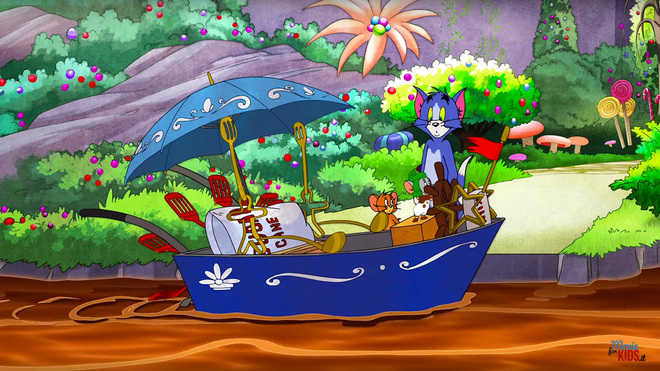Shardul Bhardwaj
Warner Bros’ Tom and Jerry: Willy Wonka and the Chocolate Factory is all set to release in the form of an animated musical feature length film. It is an adaptation of the 1971 classical musical Willy Wonka and the Chocolate Factory, except this time we have the unforgettable Tom and Jerry added to it as a generous sprinkling. The trailer and the plot line have given way to fears that this might be another case of using characters from two completely different realms in the name of children’s entertainment. Tom and Jerry in this film help Charlie Buckett secure the golden ticket for Willy Wonka’s factory tour and then secretly accompany him to later prevent Willy Wonka’s rival from stealing a special candy. It is here that the contradiction starts. Tom and Jerry is based on this perennial want that Tom the cat has to eat Jerry the mouse. The Tom and Jerry short films worked on this animosity.
It resulted in popular gags as well as the run and chase sequences.
Willy Wonka and the Chocolate Factory films have been adapted from Roald Dahl novels by the same name. These stories and characters exist in a different literary and visual tradition than Tom and Jerry. While it is not unheard of to mix two very different influences but when it is done merely in the name of children’s entertainment with no regard to the influence’s etymology, it becomes hotchpotch.
How it started
If one were to look closely at the origins of short animated films made in the 1940s and 1950s, it would be clear that these were made for boxoffices. The show was based on the love-hate relationship shared between Tom, the formidable grey tomcat, and Jerry, the underdog brown mouse who always won in their fights. The creators of the cartoon, Hannah-Barbara and MGM studios (under whom was the original run of), seemed to borrow heavily from the rich tradition of slapstick humour, which arrived with British Music Hall comedians like Fred Karno and Charlie Chaplin to Hollywood.
In the early 20th century, the British Music Hall was a ruthless place where mediocre performers would be booed of stage, while the good ones managed to enthral the noisy, merrymaking audience and keep the censors at bay in each moment on stage. Perhaps to adapt to such circumstances, Fred Karno was the first to develop a speechless sketch containing humour on the lines of slapstick comedy with underdogs playing tricks on the authority. Comedians and filmmakers like Charlie Chaplin and Stan Laurel (of Laurel and Hardy fame) were Karno’s understudies and many see him as the precursor to the silent comedy films of Hollywood.
Appeal across ages
Tom and Jerry does not assume somebody’s intellectual prowess or a kid’s lack of maturity, it appeals equally to all age groups. This series of cartoon films contain a lot of violence in run-and-chase sequences, smoking and racism (some of which have been censored); hardly a popular definition of family entertainment in the world as we know it today. The audiences have always personified the cat and the mouse as audiences go through the gamut of emotions with the two protagonists. The cartoon show continues to enthral audiences all over the world even today, more than 70 years after Tom and Jerry first appeared in Hannah-Barbara’s Puss gets the Boot (1940).
Efforts such as Tom and Jerry: Willy Wonka and the Chocolate Factory have been attempted in the past. In 1993, one saw Tom and Jerry — The Movie where it was a formulaic story of Tom and Jerry helping a little girl reunite with her father, this film also had characters like Aunt Figg from The Little Mermaid who seemed to have just walked into a different world altogether . It fell flat for more than one reason, one of them was stripping away the animosity and slapstick from in between Tom and Jerry. Gene Deitch in 1960 made a rerun of Tom and Jerry with 13 cartoon films which by the New York Times was described as “employing the flat, jazzy and economical “limited” style of UPA (United Productions of America, animation studio) it falls somewhere between a travesty and a satire of the American iteration.” The gag timing and the tradition of slapstick that Tom and Jerry come from then makes it very necessary to arrive at a well informed and thought out blend rather than bland rerun where characters from other classics are just borrowed.
An all-time favourite
Tom and Jerry has a lot in common with the silent comedy films. Firstly, there is hardly any spoken dialogue in the cartoon, which resulted in its international success. The plot is pushed forward collectively through a series of gags, chase sequences, physical comedy and slapstick, like in the silent films of Buster Keaton and Charlie Chaplin that impressed audiences universally. The background score, composed by Scott Bradley, seemed to do most of the talking. Secondly, in most of the shots the clever Jerry would outsmart Tom the cat by using his wit. This use of wit, accompanied by physical gags, illustrated the senselessness of the capitalist setup in Charlie Chaplin silent comedy films. This siding with the underdog in the short animated films of America’s golden generation of animation (1928-69) was admired by a population, which had just emerged out of the 1930s economic depression. These films articulated the desires and grinding circumstances of the dispossessed. The third commonality was the representation of recurring characters that are not defined in a psychological manner, paragons of which are the tramp in Charlie Chaplin films and the cat-mouse duo in Tom and Jerry. These shorts allow for dispensing the need for narrative and psychological logic needed in traditional realism.
Unlock Exclusive Insights with The Tribune Premium
Take your experience further with Premium access.
Thought-provoking Opinions, Expert Analysis, In-depth Insights and other Member Only Benefits
Already a Member? Sign In Now










